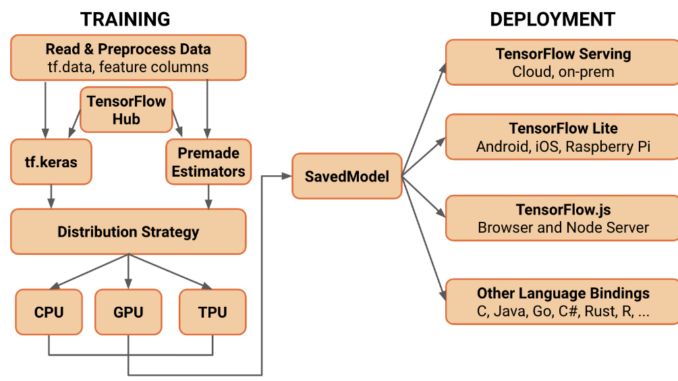
In the realm of deep learning and neural network frameworks, TensorFlow, Keras, and PyTorch stand out as the leading choices for data scientists. Each offers unique features, advantages, and use cases, catering to different needs and preferences in the machine learning field. Let’s delve into the details of each framework to understand its strengths and applications.
TensorFlow, developed by Google Brain, is an open-source machine learning library primarily known for its flexibility and scalability in building and training deep learning models. It allows for high-performance numerical computation across CPUs and GPUs.
Features:
- Graph-based computation: TensorFlow operates by constructing a computational graph that details the data flow through a series of operations.
- Support for distributed computing: Enables scaling computations across multiple CPUs and GPUs effortlessly.
- TensorBoard: Integrated visualization tool for model training and evaluation.
- Wide adoption: Widely used in research and production environments due to its robustness and community support.
Use Cases:
- Image and speech recognition
- Natural language processing (NLP)
- Time series forecasting
- Reinforcement learning
Pros:
- Excellent scalability and performance.
- Broad community support and extensive documentation.
- Seamless deployment capabilities for production environments.
Cons:
- A steeper learning curve, especially for beginners.
- Requires more boilerplate code compared to higher-level APIs.
Initially developed as a high-level API for building neural networks on top of TensorFlow, Keras has now become an integral part of TensorFlow and supports multiple backend engines.
Features:
- User-friendly: Designed for rapid development and experimentation with deep neural networks.
- Modular and extensible: Allows for easy model building through layers, making it simple to prototype complex architectures.
- Support for multiple backends: Besides TensorFlow, Keras supports Microsoft Cognitive Toolkit (CNTK) and Theano as backend engines.
Use Cases:
- Quick prototyping of deep learning models
- Education and tutorials
- Building complex network architectures with minimal code
Pros:
- Beginner-friendly and easy to learn.
- Seamless integration with TensorFlow.
- Fast experimentation and model iteration.
Cons:
- May lack flexibility in customizing models compared to TensorFlow.
- Advanced users might find limitations in complex model designs.
Developed by Facebook’s AI Research lab (FAIR), PyTorch is an open-source machine learning library known for its dynamic computational graph approach, making it more intuitive and easier to debug compared to static graph frameworks like TensorFlow.
Features:
- Dynamic computation: Allows for defining and modifying computational graphs on-the-fly, which is beneficial for debugging and fast prototyping.
- Pythonic: Integrates seamlessly with Python and feels more natural to Python programmers.
- Strong community support: Growing popularity in both academia and industry, with a vibrant community contributing to its ecosystem.
- Tensor computation with GPU acceleration: Optimized for GPU-accelerated computations.
Use Cases:
- Natural language processing (NLP) tasks
- Computer vision applications
- Reinforcement learning
- Research and academia due to flexibility and ease of use
Pros:
- Easy to learn and use, especially for Python enthusiasts.
- Excellent for rapid prototyping and research experimentation.
- Dynamic computational graph offers more flexibility.
Cons:
- Less optimized for production deployment compared to TensorFlow.
- Smaller ecosystem and fewer pre-trained models compared to TensorFlow.
When choosing between TensorFlow, Keras, and PyTorch, it’s important to consider your specific needs and project requirements. Here are some recommendations to guide your decision:
- TensorFlow: Ideal for large-scale production and deployment, TensorFlow offers robust support for complex models and advanced features like distributed computing. It’s the go-to choice for projects that require scalability and performance optimization.
- Keras: Best for beginners and rapid prototyping, Keras provides an easy-to-use API that simplifies model building and experimentation. It’s great for quick iterations and when ease of use and readability are priorities.
- PyTorch: Preferred by researchers and those who need flexibility, PyTorch’s dynamic computation graph and intuitive interface make it excellent for developing and testing new algorithms. It’s particularly well-suited for research and academic projects where customizability is key.
Consider the strengths of each framework for your project goals to make the best choice for your data science endeavors.
Choosing between TensorFlow, Keras, and PyTorch depends largely on your specific requirements, familiarity with the framework, and the nature of the project at hand. TensorFlow offers scalability and robustness, Keras provides simplicity and ease of use, while PyTorch offers flexibility and dynamic computation capabilities. Whether you’re a beginner exploring deep learning or an experienced researcher, each framework has its strengths tailored to different aspects of machine learning development.
Understanding these distinctions will empower you to make informed decisions when selecting the right tool for your next machine-learning project.
Which framework do you prefer working with, and why?
Share your thoughts in the comments below!
#TensorFlow #Keras #PyTorch #MachineLearning #DeepLearning #DataScience #AI #NeuralNetworks #LinkedInLearning

Be the first to comment